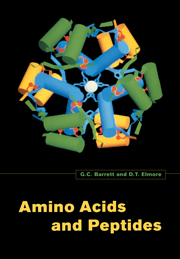Book contents
- Frontmatter
- Contents
- Foreword
- 1 Introduction
- 2 Conformations of amino acids and peptides
- 3 Physicohemical properties of amino acids and peptides
- 4 Reactions and analytical methods for amino acids and peptides
- 5 Determination of the primary structure of peptides and proteins
- 6 Synthesis of amino acids
- 7 Methods for the synthesis of peptides
- 8 Biological roles of amino acids and peptides
- 9 Some aspects of amino-acid and peptide drug design
- Subject index
9 - Some aspects of amino-acid and peptide drug design
Published online by Cambridge University Press: 05 June 2012
- Frontmatter
- Contents
- Foreword
- 1 Introduction
- 2 Conformations of amino acids and peptides
- 3 Physicohemical properties of amino acids and peptides
- 4 Reactions and analytical methods for amino acids and peptides
- 5 Determination of the primary structure of peptides and proteins
- 6 Synthesis of amino acids
- 7 Methods for the synthesis of peptides
- 8 Biological roles of amino acids and peptides
- 9 Some aspects of amino-acid and peptide drug design
- Subject index
Summary
Amino-acid antimetabolites
Amino acids are not suitable in most cases as a basis for developing antibiotics, since they occur in all naturally occurring proteins. Consequently, any attempt to deprive pathological micro-organisms of coded amino acids would cause serious damage to the human host. An exception to this general rule is found with 4-aminobenzoic acid, which is not a coded amino acid but which is present in folic acid (9.1). Humans do not require free 4-aminobenzoic acid because they cannot synthesise folic acid. Folic acid is obtained from dietary sources and from the biosynthetic activity of intestinal bacteria. Since bacteria synthesise folic acid from 4-aminobenzoic acid, an antimetabolite of this offers a possible weapon against attack by pathological micro-organisms. 4-Aminobenzenesulphonic acid structurally resembles 4-aminobenzoic acid closely (they are mutually isosteric) and inhibits the synthesis of folic acid by pathogenic organisms, not by competitive inhibition but rather by behaving as an alternative substrate for the enzyme dihydropteroate synthetase, which catalyses the reaction between 2-amino-4-hydroxy-6-hydroxymethyl-7,8-dihydropterin pyrophosphate and 4-aminobenzoic acid. The products of the alternative reaction involving sulphonamides are the expected analogues of dihydropteroate. Crucial to the efficacy of sulphonamides is the failure of folic acid to enter the bacterial cell. All the folic acid required by the bacteria must be syn-thesised inside the cell. In contrast, sulphonamides like 4-aminobenzoic acid readily enter the bacterial cell.
- Type
- Chapter
- Information
- Amino Acids and Peptides , pp. 200 - 219Publisher: Cambridge University PressPrint publication year: 1998



